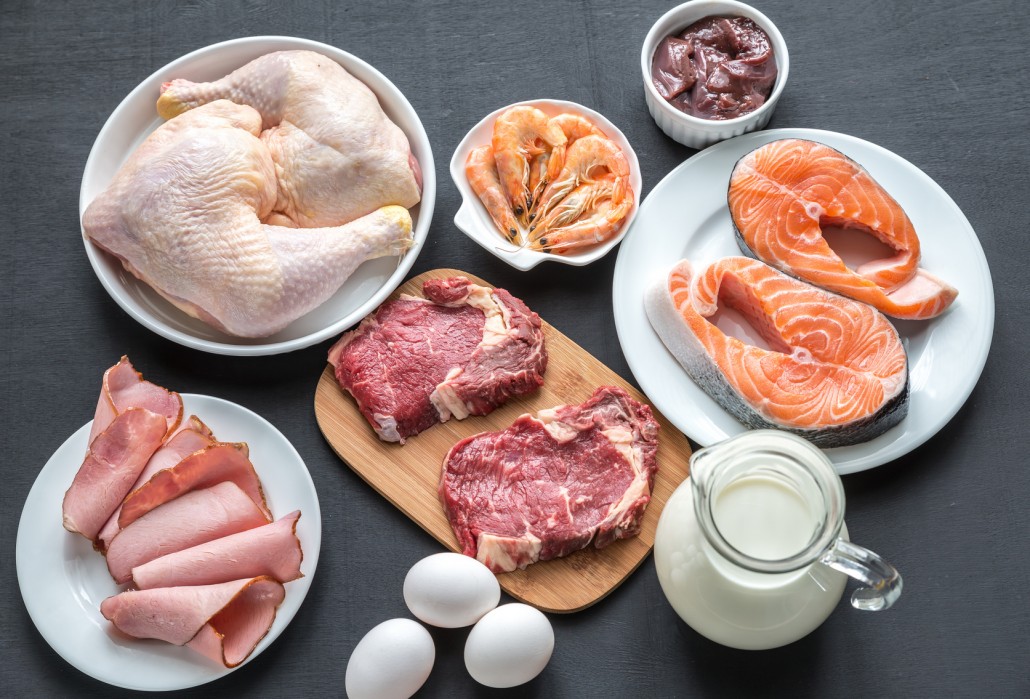Protein is incredibly important. In fact, it is the most crucial element in helping retain a healthy body composition. Protein is also vitally important when it comes to maximizing our health. The truth is our health and body composition can suffer dramatically if we don’t get enough protein in our diet.
Although there is a fairly wide spectrum of opinions when it comes to just how much protein we actually need, a majority of the recommendations are far from optimal.
For instance, most authorized nutrition organizations recommend a rather modest protein intake. In fact, both the Recommended Dietary Allowance (RDA) and the Dietary Reference Intake (DRI) endorse 0.8 grams of protein per kilogram of body weight, or just 0.36 grams per pound. (1, 2, 3)
This amounts to 46 grams per/day for the average adult female and 56 grams per/day for the average adult male. Although this may be sufficient for aiding in the prevention of deficiencies, it is far from adequate to ensure optimal health and sustain proper body composition.
As it turns out, a more desirable amount of protein for many is grossly understated and I will outline some recommendations for a more favorable protein intake in this piece.
Protein 101
Protein is an essential substance found in every cell in our body. In fact, except for water, protein is the most abundant substance in the body. Because our body is in a constant state of flux, continually breaking down and rebuilding its own tissues, we need to consume enough protein to aid in the process of making and repairing muscles, tendons, organs and skin as well as enzymes, hormones, neurotransmitters and body chemicals that serve important functions. We can accomplish this by regularly consuming foods that contain protein.
Protein, being the main building blocks of the body contains four calories per gram and is the hardest macronutrient for our bodies to disassemble and process. In fact, protein is five times more metabolically demanding than both carbohydrates and fat, thus making it the most thermogenic macronutrient (meaning the most stimulating to our metabolism). (4, 5)
Protein is made of smaller compounds called amino acids which are divided into three groups:
Essential amino acids
- Essential amino acids cannot be made by the body. As a result, they must be taken in through food.
- The nine essential amino acids are: histidine, isoleucine, leucine, lysine, methionine, phenylalanine, threonine, tryptophan, and valine.
Nonessential amino acids
- Nonessential amino acids are synthesized by the body. What this means is that the body is simply capable of creating them on its own; therefore it is not necessary for it to attain them from an outside source.
- They include: alanine, asparagine, aspartic acid, and glutamic acid.
Conditional amino acids
- Conditional amino acids are usually not essential, except in times of illness and stress.
- They include: arginine, cysteine, glutamine, tyrosine, glycine, ornithine, proline, and serine.
Under certain circumstances, our need for protein can increase. This includes periods of sickness or increased physical activity. And even though a relatively high protein intake is healthy and safe, eating massive amounts of it seems unnecessary. However, if we eat more than we need, the excess protein will either be broken down and used for energy or excreted. (6)
Here are 6 important roles that protein plays for the body.
1. Repair and Maintenance
Protein is termed the building block of the body. It is called this because protein is vital in the maintenance of body tissue, including development and repair. Hair, skin, eyes, muscles and organs are all made from protein.
2. Energy
Protein is a major source of energy. If you consume more protein than you need for body tissue maintenance and other necessary functions, your body will use it for energy by converting it to glucose through a process called gluconeogenesis or “GNG” (gluco = sugar) – (neo = new) – (genesis = creation).
3. Hormones
Protein is involved in the creation of many hormones. These substances help control body functions that involve the interaction of several organs. Insulin, a small protein, is an example of a hormone that regulates blood sugar. It involves the interaction of organs such as the pancreas and the liver. Secretin is another example of a protein hormone. This substance assists in the digestive process by stimulating the pancreas and the intestine to create necessary digestive juices.
4. Enzymes
Enzymes are proteins that increase the rate of chemical reactions in the body. In fact, most of the necessary chemical reactions in the body would not efficiently proceed without enzymes. For example, one type of enzyme functions as an aid in digesting large protein, carbohydrate and fat molecules into smaller molecules, while another assists in the creation of DNA.
5. Transportation and Storage of Molecules
Protein is a major element in the transportation of certain molecules. For example, hemoglobin is a protein that transports oxygen throughout the body. Protein is also sometimes used to store certain molecules. Ferritin is an example of a protein that combines with iron for storage in the liver.
6. Antibodies
Protein forms antibodies that help prevent infection, illness and disease. These proteins identify and assist in destroying antigens such as bacteria and viruses. They often work in conjunction with the other immune system cells. For example, these antibodies identify and then surround antigens in order to keep them contained until they can be destroyed by white blood cells.
All animal protein is complete ‘meaning’ it provides all the essential amino acids in the right ratio for us to make full use of them. So, if you’re eating animal products (like meat, fish, eggs, or dairy) every day, then you’re probably already doing pretty well with your protein intake.
For vegetarians, on the other hand, complete proteins can be obtained through certain plants, such as soy, quinoa, buckwheat, spirulina, and amaranth or by pairing things like beans and rice, legumes and seeds or nut butter and whole-grain.
These combinations don’t necessarily even have to be eaten within the same meal, so if you eat beans for lunch and rice with dinner, you’ve given yourself a complete protein.
Protein and Weight loss
Protein is incredibly valuable when it comes to losing weight. The thermic effect of protein is around 30% which means for every 100 calories of protein you consume, your body ends up seeing only 70 of those calories because of the energy it takes to break it down into usable components. (7)
Protein (at around 30% of your total caloric intake) has been shown to boost ones metabolism by up to 100 calories per day compared to lower protein diets. Another important contribution of protein is its ability to reduce appetite. Protein is much more satiating than both carbohydrates and fat. Therefore, by eating more protein, because of its ability to keep you satiated will make it much easier to stick to your weight loss journey without feeling hungry or deprived. (8, 9, 10)
A higher protein intake also helps to build and preserve muscle mass, which in turn burns more calories around the clock since muscle is the physical place where calories are burned for energy.
4 Major Benefits of Adequate Protein Intake:
- Muscle mass: Studies conclude that adequate protein intake has a positive effect on muscle mass, and is crucial in preventing muscle loss. (11, 12)
- Energy expenditure: Studies show that protein increases energy expenditure the most out of all the macronutrients. (13, 14)
- Satiety: Protein is very satiating, and increasing protein intake can lead to a decreased calorie intake thus helping with weight loss. (15)
- Lower risk of disease: Increased protein intake is shown to help protect against diseases like diabetes and obesity. (16, 17, 18)
Does Protein Have any Negative Health Effects?
Protein has been unfairly blamed for a number of problems. It has been said that a high protein diet can cause kidney damage and osteoporosis. However, none of this is supported by science.
In fact, a higher protein intake has been shown to lower blood pressure and help fight type II diabetes, which are two of the main risk factors for kidney disease. If protein really does have some detrimental effect on kidney function (which has never been proven), it is outweighed by the positive effects on these risk factors. (19, 20, 21)
Protein has also been blamed for osteoporosis, which is strange because the studies clearly show that protein can help prevent osteoporosis. So, overall, there is no evidence that a reasonably high protein intake has any adverse effects in healthy people trying to stay healthy. For example, it improves bone density and lowers the risk of fracture. It also increases IGF-1 and lean mass, both known to promote bone health. (22, 23, 24, 25)
What is a Gram of Protein?
Before we go any further lets discuss what a gram of protein is. This is a fairly common misunderstanding. When we refer to “grams of protein” what this means is grams of the macronutrient protein, not grams of a protein containing food like meat, fish or eggs. For instance, a 3 ounce serving of lean ground beef weighs 85 grams, but it only contains 22 grams of actual protein. A large egg weighs 46 grams, but it only contains 6 grams of protein. This is important to know so you are basing your intake on the actual grams of protein and not the weight of the protein source.
So what amount of protein is optimal for YOU?
Given that there is no evidence of harm for a higher protein diet and significant evidence of benefit, I suggest using my outline below.
- If you are a person sitting at a healthy weight then aiming for 0.8 grams per pound of body weight is ideal.
- If you are a person who is overweight and desire to lose some pounds then aim for 0.8 grams per pound per desired goal weight.
- If you are an extreme athlete who trains frequently then aiming for between 1.0 to 1.2 grams per pound of body weight will be an ideal target.
Because the average American male weighs 196 pounds and the average America female weighs 156 pounds this is what it looks like:
- Male: 196 x 0.8 = 156.8
- Female: 156 x 0.8 = 124.8
This amounts to roughly:
- 157 grams per day for the average male.
- 125 grams per day for the average female.
Protein Quick-list Overview
Red Meat
- 3 oz. – 21 grams
Chicken
- 3 oz. – 24 grams
Turkey
- 3 oz. – 15 grams
Fish & Seafood
- 3 oz. – 19 grams
Pork
- 3 oz. – 22 grams
Eggs and Dairy
- Egg (1 large) – 6 grams
- Milk (1 cup) – 8 grams
- Cottage cheese (½ cup) – 15 grams
- Yogurt (1 cup) – usually 8-12 grams
- Soft cheeses (mozzarella, brie, camembert) – 6 grams per oz.
- Medium cheeses (cheddar, swiss) – 7 or 8 grams per oz.
- Hard cheeses (parmesan) – 10 grams per oz.
Beans (including soy)
- Tofu (½ cup) – 20 grams
- Tofu (1 oz.) – 2.3 grams
- Most beans (black, pinto, lentils, etc.) (½ cup cooked) – 7-10 grams
- Soy beans (½ cup cooked) – 14 grams
- Split peas (½ cup cooked) – 8 grams
Nuts and Seeds
(¼ cup equals about 1 ounce)
- Peanut butter or nut butters (2 tablespoons) – 8 grams
- Almonds (¼ cup) – 8 grams
- Peanuts (¼ cup) – 9 grams
- Cashews (¼ cup) – 5 grams
- Pecans (¼ cup) – 2.5 grams
- Sunflower seeds (¼ cup) – 6 grams
- Pumpkin seeds (¼ cup) – 8 grams
- Flax seeds (¼ cup) – 8 grams


